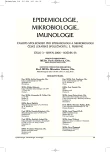Molecular Detection and Subtyping of Treponema pallidum subsp. pallidum in Clinical Specimens
Authors:
M. Flasarová 1,2; D. Šmajs 1; P. Matějková 1; V. Woznicová 2; M. Heroldová Dvořáková 2; M. Votava 2
Authors‘ workplace:
Biologický ústav, LF MU, Brno
1; Mikrobiologický ústav, LF a FN u sv. Anny, MU, Brno
2
Published in:
Epidemiol. Mikrobiol. Imunol. 55, 2006, č. 3, s. 105-111
Overview
An in-house two-step nested PCR amplification targeting the tmpC gene (TP0319, encoding putative membrane lipoprotein) was used for detection of chromosomal DNA of Treponema pallidum subsp. pallidum in clinical specimens.We tested 138 blood serum samples from 111 adult patients with suspected, primary, secondary, early or late latent syphilis. T. p. pallidum DNA was not detected in any of the analyzed specimens. Out of 11 mucocutaneous swabs (7 genital and 4 pharyngeal), 6 collected from 3 patients with primary or secondary syphilis tested positive. One skin swab from a patient with early congenital syphilis was also positive as were his serum and cerebrospinal fluid samples. DNA sequencing of the genes TP0136 and TP0548 from the positive samples revealed two strains with DNA sequences identical to that of T. p. pallidum strain SS14 and two unique previously undescribed T. p. pallidum strains. The advances in molecular typing of T. p. pallidum in clinical specimens will be of relevance to the epidemiology of syphilis and will allow for clinical discrimination between reinfection and syphilitic reactivation.
Key words:
Treponema pallidum subsp. pallidum – detection in clinical specimens – molecular typing – mucocutaneous swabs.
Labels
Hygiene and epidemiology Medical virology Clinical microbiologyArticle was published in
Epidemiology, Microbiology, Immunology

2006 Issue 3
Most read in this issue
- Aeromonas spp. as the Causative Agent of Acute Diarrhoea in Children under 1 Year of Age
- Head Louse: Taxonomy, Incidence, Resistance, Delousing
- Seroprevalence of Antibodies Against Hepatitis A Virus and Hepatitis B Virus in Nonvaccinated Adult Population over 40 Years of Age
- Molecular Detection and Subtyping of Treponema pallidum subsp. pallidum in Clinical Specimens
